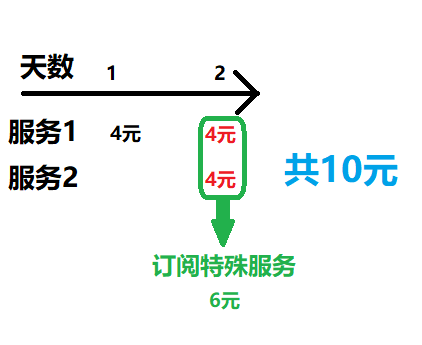AtCoder Beginner Contest 188 A~D 题解
A - Three-Point Shot
题目大意
有两个球队,分别得到\(X\)分和\(Y\)分,问得分较少的球队能否在获得三分后超越对方。
\(0\le X,Y\le 100\)
\(X \ne Y\)
\(X\)和\(Y\)都是整数。
输入格式
\(X~Y\)
输出格式
如果能,输出Yes;否则,输出No。
样例
| X | Y | 输出 |
|---|---|---|
| 3 | 5 | Yes |
分析
这个不用说了吧,就是求两个数的差是否小于\(3\)……
代码
#include <cstdio>
#include <algorithm>
using namespace std;
int main(int argc, char** argv)
{
int a, b;
scanf("%d%d", &a, &b);
puts((abs(a - b) < 3)? "Yes": "No");
return 0;
}
B - Orthogonality
题目大意
给定两个长度为\(N\)的数组\(A=\{A_1,A_2,A_3,...,A_N\}\)和\(B=\{B_1,B_2,B_3,...,B_N\}\)。请判定\(A\)和\(B\)的内项积是否为\(0\)。换句话说,判断\(\sum\limits_{i=1}^NA_iB_i\)是否为\(0\)。
\(1\le N\le 10^5\)
\(-100\le A_i,B_i\le 100\) 注意:可能会出现负数!
输入格式
\(N\)
\(A_1~A_2~A_3~\dots~A_N\)
\(B_1~B_2~B_3~\dots~B_N\)
输出格式
如果\(A\)和\(B\)的内项积为\(0\),输出Yes;否则,输出No。
样例
样例输入1
2
-3 6
4 2
样例输出1
Yes
\(N = 2\)
\(A = \{-3,6\}\)
\(B = \{4,2\}\)
\(A\)和\(B\)的内项积为:\(\sum\limits_{i=1}^NA_iB_i = (-3)\times4+6\times2=0\),所以输出Yes。
样例输入2
2
4 5
-1 -3
样例输出2
No
\(N = 2\)
\(A = \{4,5\}\)
\(B = \{-1,-3\}\)
\(A\)和\(B\)的内项积为:\(\sum\limits_{i=1}^NA_iB_i = 4\times(-1)+5\times(-3)=19\),所以输出No。
样例输入3
3
1 3 5
3 -6 3
样例输出3
Yes
\(N = 3\)
\(A = \{1,3,5\}\)
\(B = \{3,-6,3\}\)
\(A\)和\(B\)的内项积为:\(\sum\limits_{i=1}^NA_iB_i = 1\times3+3\times(-6)+5\times3=0\),所以输出Yes。
分析
只需按题目说的照做即可。
代码
#include <cstdio>
#define maxn 100005
using namespace std;
int a[maxn];
int main(int argc, char** argv)
{
int n;
scanf("%d", &n);
for(int i=0; i<n; i++)
scanf("%d", a + i);
int res = 0;
for(int i=0; i<n; i++)
{
int x;
scanf("%d", &x);
res += x * a[i];
}
puts(res == 0? "Yes": "No");
return 0;
}
C - ABC Tournament
题目大意
有\(2^N\)个玩家,每个玩家的编号是\(i\)且有一个排名\(A_i\),举行\(N\)场淘汰赛。
淘汰赛可以看作一棵二叉树,制度如下:
如,\(N=3\),有\(8\)个玩家,排名分别为\(1,6,7,10,5,13,8,9\):
1,6,7,10,5,13,8,9 两两比较,淘汰1,7,5,8;(排名越高的玩家越厉害)6,10,13,9两两比较,淘汰6,9;10,13 \(13\)最大,胜利!
请输出比赛的第二名(即在最后一轮被淘汰的玩家,如上面的\(13\))的编号。
\(1\le N\le 16\)
\(1\le A_i \le 10^9\)
\(A_i\)互不相同。
输入格式
\(N\)
\(A_1~A_2~A_3~\dots~A_{2^N}\)
输出格式
输出最终获得第二名的玩家的编号。
样例
样例输入1
2
1 4 2 5
样例输出1
2
\(4\)个玩家,排名分别为\(1,4,2,5\):
1,4,2,54,5(\(2\)号玩家在这里被淘汰了)
所以,我们输出\(2\)。
样例输入2
2
3 1 5 4
样例输出2
1
\(4\)个玩家,排名分别为\(3,1,5,4\):
- 3,
1,5,4 3,5(\(1\)号玩家在这里被淘汰了)
所以,我们输出\(1\)。
样例输入3
4
6 13 12 5 3 7 10 11 16 9 8 15 2 1 14 4
样例输出3
2
博主提示:在这个样例上手算,就可以知道不能将输入排序后取第二大的值!!!
分析
首先,题目不允许偷懒(要求第二名的编号),不能将输入排序后取第二大的值。
我们考虑别的方法。
很容易想到,可以直接模拟。不过,模拟时不能直接删除元素,会TLE。可以采取利用循环队列的\(\mathcal O(1)\)进出,每次出队两个元素,再将其中较大的再放入队列即可。最后,当队列中只剩两个元素时,输出其中较小的编号即可。
代码
写代码时要注意两点:
- 一定要使用
long long! - 要在进行队列操作时记录编号,可以用
pair实现。
#include <cstdio>
#include <queue>
using namespace std;
using LL = long long;
using pli = pair<LL, int>;
int main(int argc, char** argv)
{
queue<pli> q;
int n;
scanf("%d", &n);
n = 1 << n;
for(int i=1; i<=n; i++)
{
LL x;
scanf("%lld", &x);
q.emplace(x, i);
}
while(q.size() > 2)
{
pli x = q.front(); q.pop();
pli y = q.front(); q.pop();
if(x < y) q.push(y);
else q.push(x);
}
pli x = q.front(); q.pop();
pli y = q.front();
printf("%d\n", x < y? x.second: y.second);
return 0;
}
D - Snuke Prime
题目大意
Takahashi需要使用\(N\)种服务。
每种服务的价格是\(c_i\)元(原题中钱币单位是日元,翻译时使用人民币作单位),他需要从第\(a_i\)天的开始(0:00)用到第\(b_i\)天的结束(23:59)。有一种特殊的服务,它可以使你无限次使用任意其它服务,每天收费\(C\)元(需要从一天的开始订阅到一天的结束,订阅结束时失效,可以多次订阅)。
Takahashi使用这些服务至少需要多少元?
\(1\le N\le 2\times 10^5\)
\(1\le C\le 10^9\)
\(1\le a_i\le b_i\le 10^9\)
\(1\le c_i\le 10^9\)
输入格式
\(N~C\)
\(a_1~b_1~c_1\)
\(a_2~b_2~c_2\)
\(...\)
\(a_N~b_N~c_N\)
输出格式
输出一行,即最少需要的钱数。
样例
样例输入1
2 6
1 2 4
2 2 4
样例输出1
10

样例输入2
5 1000000000
583563238 820642330 44577
136809000 653199778 90962
54601291 785892285 50554
5797762 453599267 65697
468677897 916692569 87409
样例输出2
163089627821228
最优方案是不订阅特殊服务。
样例输入3
5 100000
583563238 820642330 44577
136809000 653199778 90962
54601291 785892285 50554
5797762 453599267 65697
468677897 916692569 87409
样例输出3
88206004785464
自制样例
博主在这里再提供一组样例,方便手算后面的代码以及理解题目的意思。
输入:
2 7
1 3 5
2 6 4
输出:
31
在这组数据中,我们在第\(2\)、\(3\)天订阅特殊服务。
分析
参考:AtCoder官方题解
我们可以把每一个服务的订阅拆分成两个事件\((a_i-1,c_i)\)和\((b_i,-c_i)\)。每个事件有两个参数,分别是时间(某一天的最后一刻)和每天增加的钱数(可以为负数,表示减少需要花的钱)。然后,再按时间排序这些事件。
我们可以用变量fee记录每天需要花的钱,用ans记录答案。循环遍历每个事件,当这个事件的事件与上一次不同时,将ans加上计算最划算的付钱方法(分开付,要花fee元或一起付,花\(C\)元)乘以与上一次差的天数,最后加上当前事件的增加钱数。
最后,输出ans即可。
代码
作为一个优先队列爱好者,排序当然是用priority_queue实现了~
以下代码要注意三点:
- 必须使用
long long; - 建议使用
pair存储; - 拆分事件时第一个事件\((a_i-1,c_i)\)中的\(a_i\)一定不能忘记\(-1\)(因为\(a_i\)表示的是一天的开始,应该转换为前一天的结束)。
#include <cstdio>
#include <vector>
#include <queue>
#include <algorithm>
using namespace std;
typedef long long LL;
typedef pair<LL, LL> pll;
int main(int argc, char** argv)
{
int n;
LL c;
scanf("%d%lld", &n, &c);
priority_queue<pll, vector<pll>, greater<pll> > q;
while(n--)
{
LL x, y, z;
scanf("%lld%lld%lld", &x, &y, &z);
q.emplace(--x, z);
q.emplace(y, -z);
}
LL ans = 0LL, fee = 0LL, last = 0LL;
while(!q.empty())
{
auto [day, cost] = q.top(); q.pop();
if(last != day)
{
ans += min(c, fee) * (day - last);
last = day;
}
fee += cost;
}
printf("%lld\n", ans);
return 0;
}
上面的代码使用了C++17新特性,如果上面的代码无法通过本地编译,请使用下面的代码:
#include <cstdio>
#include <vector>
#include <queue>
#include <algorithm>
using namespace std;
typedef long long LL;
typedef pair<LL, LL> pll;
int main(int argc, char** argv)
{
int n;
LL c;
scanf("%d%lld", &n, &c);
priority_queue<pll, vector<pll>, greater<pll> > q;
while(n--)
{
LL x, y, z;
scanf("%lld%lld%lld", &x, &y, &z);
q.push(pll(--x, z));
q.push(pll(y, -z));
}
LL ans = 0LL, fee = 0LL, last = 0LL;
while(!q.empty())
{
LL day = q.top().first, cost = q.top().second; q.pop();
if(last != day)
{
ans += min(c, fee) * (day - last);
last = day;
}
fee += cost;
}
printf("%lld\n", ans);
return 0;
}


 浙公网安备 33010602011771号
浙公网安备 33010602011771号